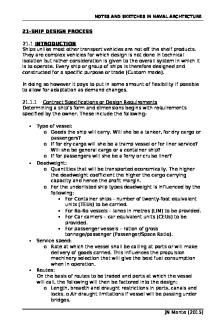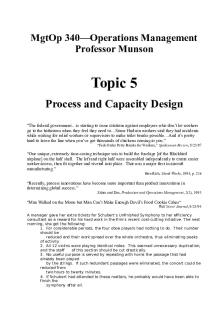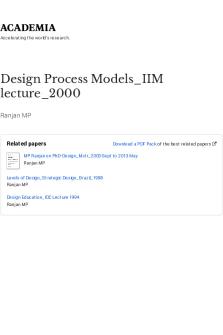Topic 5 - Process and Capacity Design PDF

| Title | Topic 5 - Process and Capacity Design |
|---|---|
| Course | Operations Management |
| Institution | Washington State University |
| Pages | 34 |
| File Size | 751.9 KB |
| File Type | |
| Total Downloads | 27 |
| Total Views | 138 |
Summary
Download Topic 5 - Process and Capacity Design PDF
Description
MgtOp 340—Operations Management Professor Munson
Topic 5 Process and Capacity Design “The federal government…is starting to issue citations against employers who don’t let workers go to the bathroom when they feel they need to…Some Hudson workers said they had accidents while waiting for relief workers or supervisors to make toilet breaks possible…And it’s pretty hard to leave the line when you’ve got thousands of chickens coming at you.” “Feds Order Potty Breaks for Workers,” Spokesman-Review , 8/23/97
“One unique, extremely time-saving technique was to build the fuselage [of the Blackbird airplane] on the half shell. The left and right half were assembled independently to create easier worker access, then fit together and riveted into place. That was a major first in aircraft manufacturing.” Ben Rich, Skunk Works, 1994, p. 216
“Recently, process innovations have become more important than product innovations in determining global success.” Zahra and Das, Production and Operations Management, 2(1), 1993
“Man Walked on the Moon but Man Can’t Make Enough Devil’s Food Cookie Cakes” Wall Street Journal, 9/23/94 A manager gave her extra tickets for Schubert’s Unfinished Symphony to her efficiency consultant as a reward for his hard work in the firm’s recent cost-cutting initiative. The next morning, she got the following: 1. For considerable periods, the four oboe players had nothing to do. Their number should be reduced and their work spread over the whole orchestra, thus eliminating peaks of activity. 2. All 12 violins were playing identical notes. This seemed unnecessary duplication, and the staff of this section should be cut drastically. 3. No useful purpose is served by repeating with horns the passage that had already been played by the strings. If such redundant passages were eliminated, the concert could be reduced from two hours to twenty minutes. 4. If Schubert had attended to these matters, he probably would have been able to finish the symphony after all.
“Moving fast is not the same as going somewhere.” All I Need to Know About Manufacturing I Learned in Joe’s Garage, 2008, p. 48
Process Design Videos Modern Times Lucy
Baggage Guarantee at Alaska Airlines Green Mfcting. & Sustainability at Frito-Lay
Sustainability and the Amway Center
Capacity Analysis: Sample Problems Definitions process time (at a workstation) The time to produce a unit (or specified batch of units) at that workstation (e.g. 1 hour for 5 cars). bottleneck An operation that has the lowest effective capacity of any operation in the production system and thus limits the system’s output. bottleneck time The process time of the longest (slowest) process, i.e., the bottleneck. throughput time (or, manufacturing lead time) The time it takes one unit (or batch) of product to go through the entire production process with no waiting. process flow diagram Traces the flow of materials through a process (assembly line).
Example 1—Bread Making on Two Lines Initial Assumptions The bakery sells only white bread. Two parallel baking lines, each equipped with a mixer, a proofer, and an oven. The two baking lines share a single packaging line. 8-hour work day
Which process is the bottleneck within each baking line? What is the bottleneck time of the 1st baking line? The 2nd?
What is the bottleneck time for the entire baking line operation?
What is the bottleneck time for the entire breadmaking process? What is the throughput time for the entire breadmaking process?
How should the baking lines be scheduled (started together or staggered; run continuously or with idle time)?
What is the overall daily capacity of the breadmaking operation?
Option A: The bakery is considering replacing some of its existing equipment with more advanced and faster equipment. The choice is between: (i) purchasing two new ovens that are each capable of baking a batch of 100 loaves in ¾ hour, or (ii) purchasing a new packaging line that is capable of packaging a batch of 100 loaves in ½ hour. Which option would allow the greatest increase in the bakery’s overall capacity?
What is the new overall daily capacity?
Option B: The bakery is considering producing wheat bread in addition to white bread. Assume that equal quantities of each bread would be produced. The packaging line would switch between packaging white and wheat bread every 100 loaves, i.e., every batch. It would take ¼ hour to change bags on the packaging line to switch from white bread to wheat and vice-versa. (Assume no setup time to switch bread type made on either baking line.)
What would be the overall bottleneck time of the process? What would be the new daily capacity? Would it help to package all white bread first and then all wheat bread?
Example 2—Croissant Manufacturing Assumptions Making dough and mixing filling are done separately. Both making dough and mixing filling must be finished before croissants can be filled, folded, baked, and packed. 8-hour work day
What is the bottleneck time of the dough making line? What is the bottleneck time of the combined dough making and mixing filling operations? What is the bottleneck time of the entire
croissant making process? What is the overall daily capacity? What is the throughput time of the croissant making process? Figure 5
Gantt Chart for Croissant Making
Mix Proof Roll & Cut Mix Filling Fill & Fold Bake Pack 5 10
20
30 Batch #1
40 TIME
50
60
70
80
Batch #2
What if we had started Batch #2 immediately after Batch #1 was mixed?
Example 3—Automobile Component Assembly Figure 6 Raw Materials
XYZ Component Operation
Mold parts
Molded parts Inventory Final Assembly
Purchase parts From Vendors
Finished Components
Purchased parts Inventory
Assumptions One worker is needed to operate each machine in the molding dept. The molding dept. has 10 machines. Currently 6 workers in the molding dept., earning $15 per hour. Molding machines produce 25 parts/hour. Molding workers will work overtime at a 50% wage premium (now work 8 hrs./day). The purchased parts operation has virtually unlimited capacity. 15 workers in final assembly working an 8hour shift and earning $10 per hour. 5-day work week. Assembly line moves at 150 parts per hour. What is the weekly capacity of the molding
operation?
What is the weekly capacity of the assembly operation?
What is the weekly capacity of the entire operation?
What is the labor cost per part in the molding dept.? What is the labor cost per part in the assembly dept.?
Assume that direct variable costs per part other than labor amount to $5.00, and suppose that
each part sells for $7.00. What is the gross margin per part?
Expansion Option: Suppose that 4 workers are added to the molding dept. so that all 10 machines are utilized. What is the new capacity of the molding dept.?
Suppose that a 2nd shift is added to the assembly dept. What is the new capacity of the assembly dept.?
How much overtime would each of the 10 workers in molding have to work in order to balance the process now that a 2nd shift is working?
What would be the total labor cost per part of the units produced during overtime?
Suppose that a corporate buyer is willing to purchase all parts produced during the second shift each week, but only if a quantity discount reduces the price to $6.80 per part. Should the firm proceed with the expansion option?
Capacity Analysis Summary Example
To find the bottleneck time: 1. Adjust for any parallel processes. 2. Choose the largest. To find the throughput time: 1. Calculate time through every path in the system (ignore parallel processes). 2. Choose the largest. Sawing
Sanding
10 min./unit
4 min./unit
Drilling 12 min./unit
Measuring
Finishing
Line 1
8 min./unit
2 min./unit
Sawing
Sanding
10 min./unit
4 min./unit
Drilling 12 min./unit
Line 2
1. Bottleneck? 2. Bottleneck Time? 3. Throughput Time?
Capacity Planning Capacity is the limiting capability of a productive unit to produce within a stated time period, normally expressed in terms of output units per unit of time. Buffa and Sarin, Modern Production/Operations Management, Wiley, 1987.
Measures of Capacity Maximum output rate Maximum input rate Quantity of input units Examples of Capacity Measures Organization auto plant steel plant beer brewery airline restaurant warehouse foundry hospital business school
Output Measure Input Measure cars per week available labor hrs. tons of steel per month iron ore receivable per day cases of beer per year daily aluminum can production passengers per month number of seats customers per day available seat-turns cases picked per day square feet of space daily pieces produced number of molds surgeries per day hospital beds sections per semester number of faculty
Capacity Planning Issues Scale Economies Economies
Diseconomies
Sources of Capacity Short Term
Long Term
Options for Capacity Increase On-site Expansion Advantages
─ ─ ─ ─
Disadvantages
─ ─ ─ ─
generally cheapest does not disperse existing labor force no product or process separation possible economies of scale
deoptimizes layout postpones introduction of new technology increased complexity strains management larger workforce may cause deteriorated labor relations (possibly unions) ─ disaster risk
New Branch Advantages
─ can use new technology ─ can design optimal layout ─ can tailor policies and systems
Disadvantages
─ multi-site overhead ─ cannot solve base plant problems
Relocation Advantages
─ ─ ─ ─
Disadvantages
─ moving and startup costs ─ might lose good people ─ disaster risk
layout materials handling and storage new technology possible economies of scale
Extreme Policies and Their Advantages Build Huge Capacity Increments 1. Economies of scale in construction and equipment purchase 2. Avoid effects of inflation 3. Flexibility in output rate
Add Capacity in Small Increments 1. Do not tie up capital in unproductive capacity 2. Avoid effects of overestimating demand (especially when there’s a change in customer tastes) 3. More flexibility in changing location and adding/using new technology
Utilization and Efficiency Design Capacity Throughput under ideal conditions during the time that the system is available. Example: If machines at Frito-Lay are designed to produce 1,200 bags of chips/hr., and the plant operates 20 hrs./day: Design capacity = 1,200 bags/hr. × 20 hrs./day = 24,000 bags/day
Effective Capacity Design capacity minus lost output due to planned resource unavailability Example: If Frito-Lay loses 4 hours of output per day (namely 1 hr./day on preventive maintenance, 1 hr./day on employee breaks, and 2 hrs./day setting up machines for different products): Effective capacity = 24,000 bags/day − (1,200 bags/hr.)(4 hrs./day) = 24,000 bags/day – 4,800 bags/day = 19,200 bags/day
Actual Output
Effective capacity minus lost output due to unplanned resource idleness Example: On average, if machines at Frito-Lay are not running 1.5 hrs./day due to late parts and machine breakdowns: Actual output = 19,200 bags/day − (1,200 bags/hr.)(1.5 hr./day) = 19,200 bags/day – 1,800 bags/day = 17,400 bags/day
Two Measures of System Performance: Utilization = Actual output / Design capacity Efficiency = Actual output / Effective capacity Frito-Lay Example: Utilization = Efficiency =
Capacity and Operational Hedging in International Distribution Networks Ways to Handle Exchange Rate Risk 1. 2. 3. Example A company has a plant in both the U.S. and the United Kingdom, as well as demand in both countries. A U.S.-based shipper charges $1.00 per unit to ship between the two countries. Assume no taxes. Monthly Demand Monthly Capacity Sales Price Production Cost
U.S. 10,000 15,000 $12 $6
U.K. 8,000 12,000 ₤6 ₤3
Determine the production volumes in each country under the following three conditions. 1. Exchange Rate: $2 = ₤1
2. Exchange Rate: $3 = ₤1 (dollar depreciates)
3. Exchange Rate: $1 = ₤1 (dollar appreciates)
Process Design Process design: Selection of inputs, operations, work flows, and methods. Causes of process (re)design: New product Change in competitive priorities Change in volume Poor performance New technology Change in cost/availability of inputs Legislation/regulation
Dimensions of Process Design Capital Intensity Resource Flexibility Vertical Integration Consumer Involvement
Product-Process Matrix
The Process Spectrum Job Shop↔Batch Process↔Line Flow↔Continuous Process
Labor Labor Content Per $ Value of Product Required Labor Skills Training Worker Discretion over Production Pace Payment System Materials and Machinery Certainty of Input Requirements Supplier Ties Vertical Integration WIP Inventory Equipment Capital Investment Planning and Control Long-Term Sales Forecasts Capacity Utilization Scheduling Quality Control Management Tasks Staff Needs vs. Line Long-Term vs. Day-to-Day
Process Capability Use the process capability index Cpk to determine if the process is generally producing within the spec limits (99.73% of time if a normal distribution). Calculate the mean μ and standard deviation σ. USL LSL C pk min , 3 3
min(A, B) = the smaller of A or B
If Cpk < 1, then the process is not capable, and must be improved. If Cpk ≥ 1, then the process is capable. Example LSL = 50, USL = 110, μ = 60, σ = 10
Process Choice with Imperfect Machines
Assuming that output is normally distributed N(μ, σ 2) with a given natural process variability σ 2:
Calculate the effective yield loss by computing the probability that the output will fall outside the specification limits (using the Z-table)
Probability(output > upper spec limit) = 1 - Ф(Zup), where Zup = (USL - center) / σ
Probability(output < lower spec limit) = Ф(Zdown), where Zdown = (LSL - center) / σ
Yield Loss = P(>USL) + P(...
Similar Free PDFs

Topic 5 - Criminal Capacity
- 10 Pages

Topic 5 Process Analysis
- 40 Pages

Design Capacity Tables Examples
- 8 Pages

Process Design
- 6 Pages

Chemical Process Design and Simulation
- 418 Pages

CH3-Product and Process Design
- 29 Pages

Chapter 5- CONTRACTUAL CAPACITY
- 5 Pages

Chapter 5- Capacity Planning
- 5 Pages

-Ship Design Process
- 1 Pages

Capacity, Planning and Control
- 9 Pages

Topic 5 and seminar 5 - 2018
- 17 Pages

Chapter 5 - Design and Layout
- 7 Pages
Popular Institutions
- Tinajero National High School - Annex
- Politeknik Caltex Riau
- Yokohama City University
- SGT University
- University of Al-Qadisiyah
- Divine Word College of Vigan
- Techniek College Rotterdam
- Universidade de Santiago
- Universiti Teknologi MARA Cawangan Johor Kampus Pasir Gudang
- Poltekkes Kemenkes Yogyakarta
- Baguio City National High School
- Colegio san marcos
- preparatoria uno
- Centro de Bachillerato Tecnológico Industrial y de Servicios No. 107
- Dalian Maritime University
- Quang Trung Secondary School
- Colegio Tecnológico en Informática
- Corporación Regional de Educación Superior
- Grupo CEDVA
- Dar Al Uloom University
- Centro de Estudios Preuniversitarios de la Universidad Nacional de Ingeniería
- 上智大学
- Aakash International School, Nuna Majara
- San Felipe Neri Catholic School
- Kang Chiao International School - New Taipei City
- Misamis Occidental National High School
- Institución Educativa Escuela Normal Juan Ladrilleros
- Kolehiyo ng Pantukan
- Batanes State College
- Instituto Continental
- Sekolah Menengah Kejuruan Kesehatan Kaltara (Tarakan)
- Colegio de La Inmaculada Concepcion - Cebu



